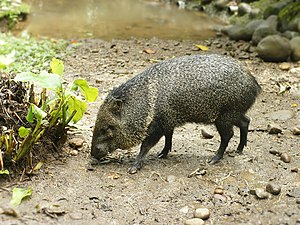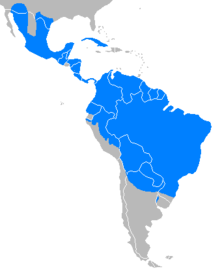Collared peccary
| Collared peccary | ||||||||||||
|---|---|---|---|---|---|---|---|---|---|---|---|---|

Collared pekari ( Pecari tajacu ) |
||||||||||||
| Systematics | ||||||||||||
|
||||||||||||
| Scientific name of the genus | ||||||||||||
| Pecari | ||||||||||||
| Reichenbach , 1835 | ||||||||||||
| Scientific name of the species | ||||||||||||
| Pecari tajacu | ||||||||||||
| ( Linnaeus , 1758) |
The collared peccary ( Pecari tajacu ) is on the Americas living peccary .
The specific epithet tajacu in the scientific name is one of the names for the animal in the language of the Tupi people . It refers to the food of the collar peccary, which consists mainly of floury tubers and roots.
features
The 14-30 kg collar peccary has a body length of 75 to 100 cm, a standing height of 40 to 60 cm, and a tail length of 1 to 5 cm. Males and females are about the same size. The fur of the old animals is dark gray with a white, often inconspicuous collar, that of the young is reddish with a narrow black stripe on the back.

The anatomy of the jaw allows the animal to open its mouth at an angle of 90 degrees. The canines are then brought into position powerfully.
Occurrence
The distribution area extends from the southwest USA ( Arizona , New Mexico , Texas ) over Central and Central America, to the Río de la Plata in Argentina . It also lives in Trinidad. The very adaptable Collared Peccary occurs in different habitats such as primeval forests, savannas, grass steppes and semi-deserts, it even penetrates into the mountains of the Andean foothills. Apparently it prefers steep river valleys and thickets.
The collar peccary is still quite common in large parts of the distribution area, as it proves to be very adaptable.
Hazardous situation
The IUCN does not classify the species as endangered due to the large distribution and range of habitats. However, the IUCN believes it is necessary to monitor the status of all populations, as ongoing habitat loss and potentially overly intensive hunting may require a different classification.
food
The collared peccary feeds on berries, shoots, tubers, but also maggots, worms and small vertebrates such as snakes and lizards. Even poisonous snakes are overwhelmed, shredded, and eaten.
Way of life
Collared peccaries live in groups of 2 to 50 but mostly 5 to 15 animals, mixed in age and sex, together to drive away enemies together. These flocks move in search of food in home areas from 0.5 to 8 square kilometers in size. Within this territory, they mark all sorts of conspicuous stones, branches and trees with the scented secretion from their dorsal glands. Like most ungulates, Collared Peccaries are predominantly diurnal, with the main activity time being in the evening and morning hours. The animals clean each other by rubbing their faces together. The main enemies are the big, American big cats, the puma and the jaguar . In the north of the distribution area wolves were once a threat, in the south they fall victim to caimans . Piglets can also be dangerous depending on the area, lynx, ocelots, coyotes, giant snakes and birds of prey.
Reproduction
The female mates with several males. There is no fixed breeding season, and so the young are born in every season. After a gestation period of around 140 days, two piglets are usually born that can walk shortly after birth. At birth, the female separates from the herd and then brings the relatively well-developed young to the herd. Collared peccaries are sexually mature after one year and can reach an age of up to 25 years.
literature
- Ronald M. Nowak: Walker's Mammals of the World . Johns Hopkins University Press, 1999 ISBN 0-8018-5789-9
Web links
Individual evidence
- ↑ Stangl, Christiansen & Galbraith (1993) Tayassu tajacu , Abbreviated guide to pronunciation and etymology of scientific names for North American land mammals north of Mexico, Museum of Texas Tech University, p. 25
- ↑ Pecari tajacu in the IUCN Red List of Threatened Species 2011.2. Listed by: J. Gongora et al., 2011. Retrieved March 22, 2012.

